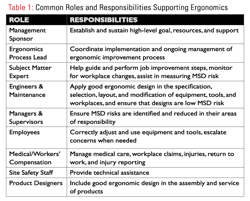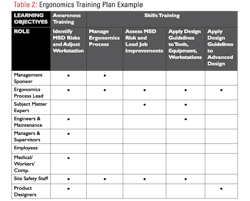Training is a common element of an organization's ergonomics program. Whether you manage ergonomics as a program or as a continuous improvement process, national organizations like OSHA, the National Institute for Occupational Safety and Health and others agree that training is essential.
Worldwide, at least 28 percent of current regulations specific to ergonomics require awareness training for employees. However, in my experience, this training rarely is well-planned or effective. How can you be confident that the time, effort and resources you spend on ergonomics training really helps your organization achieve its goal?
The key to effective training lies in defining two things: the learning objectives and the delivery method. But, before you dive in, you'll need to make sure participants are ready for what's in store.
Prepare Participants
Benchmarking studies show that organizations are most effective in reducing musculoskeletal disorders (MSDs) and engaging participants when roles, responsibilities and expectations of all team members (as well as the goal of the ergonomics process as a whole) are well deA transparent plan motivates those managing and implementing the process to deliver and drives the preparatory phase into the training phase. Participants gain the knowledge, skills and confidence to apply the tools and methods to identify and control MSD risks in the workplace.
Define Learning Objectives: What to Train
We receive calls from employers every day requesting ergonomics training. When we ask them, "What do you expect people to do as a result of training?" we usually get an uncomfortable silence or the response, "I don't know." That's because no single ergonomics training course can provide the right information to a group of people with varied roles and responsibilities. What makes it even more difficult is that most people, especially those new to supporting ergonomics, don't have the education or experience to achieve what's expected. A successful training course will provide the information and tools for people to gain the skills necessary to be successful in their roles.
Designing your training curriculum around learning objectives is critical. Learning objectives are the specific goals that students should master upon completing the course. For ergonomics-specific training, the learning objectives must align with the roles and responsibilities established for your ergonomics process (refer to Table 1).
Consider two types of learning objectives:
→ Skills training provides the "resident expert" with the knowledge, skills, capabilities and confidence to perform the technical tasks using ergonomics tools and resources. The learning objectives might include conducting MSD risk assessments, applying ergonomic design guidelines to tools and equipment, leading improvement projects or leading the ergonomics process. Skills training provides advanced knowledge and capability for subject matter experts (ergonomics team members), engineers and product designers.
→ Awareness training is geared toward the general population (managers, supervisors a nd employees). Learning objectives may include providing general knowledge about the organization's ergonomic improvement process and the tools available to identify potential MSD risk factors, andWhen the roles (Table 1) are combined with learning objectives, a training plan that ensures all team members are set up for success can be finalized. Table 2 is an example of a simple, yet comprehensive plan.
Define Delivery: How to Train
How ergonomics training is delivered is just as important as what is delivered (the learning objectives). Since most employees are adults, ergonomics training must be designed for and delivered in a way that adults learn. In addition, blended learning and the "flipped classroom" are effective ergonomics training delivery methods.
Adult learning is very different from how we once learned in school. Educational organizations describe adult learning in a variety of ways, but all are based on the same principles. The Canadian Literacy and
Learning Network (2013) describes these principles:
- Adults cannot be made to learn. They only will learn when they are internally motivated to do so.
- Adults only will learn what they feel they need to learn. In other words, they are practical.
- Adults learn by doing. Active participation especially is important to adult learners in comparison to children.
- Adult learning is problem-based and the problems must be realistic. Adult learners like finding solutions to problems.
- Adult learning is affected by the experience each adult brings.
- Adults learn best informally, what they feel they need to know, whereas children learn from a curriculum.
- Adults want information that will help them improve their situation or that of their children.
Based on these principles, classroom lectures don't promote active learning and delivery methods should be revised.
Xun Kuang, a Chinese Confucian philosopher in 312-230 BC, summarized the basis of adult learning as:
"Not having heard something is not as good as having heard it; having heard it is not as good as having seen it; having seen it is not as good as knowing it; knowing it is not as good as putting it into practice."
Blended Learning
Many organizations continue to struggle with scheduling and filling a classroom training program, finding the best time for an employee to be pulled away from work to attend a training and then are frustrated when the employee returns to work and the lessons learned aren't practiced or simply are forgotten. With technology integrated into learning management systems and online and self-paced training courses, blended learning is becoming an effective way to deliver both skills and awareness training for ergonomics.
Blended learning is an education method in which the content and instruction is delivered in a combination of two ways: online and hands-on. In the recent benchmarking survey, "Ergonomics and Technology," over half of the participating companies indicated they were moving away from classroom to online training.
Well-designed online training allows students to control the place, time, path and pace of their learning and eliminates the overall coordination and cost of filling a classroom (not to mention the burden of arranging schedules for multiple participants). It allows training content to be updated, delivered and tracked effectively and efficiently across global locations and in different languages.
After completing online training, students continue to hands-on application. Students can practice and perfect the concepts, information, tools and methods in a real workplace situation; this aligns with the principle learn by doing.
The Flipped Classroom
The "flipped classroom" is a recently developed form of blended learning that flips the order of traditional training. Students first learn principles and concepts independently through online or self-study. Next, they work alongside an instructor to apply what they have learned.
For example, after learning ergonomics concepts, assessment methods and design tools online, the student completes risk assessments, applies ergonomic design criteria, makes workplace changes and enters the information into a database. The instructor is able to evaluate how each student applies the learned information, correct and coach the student if needed, clarify key points, provide feedback, verify learning and address questions. This feedback strengthens the student's confidence in his or her abilities and work. As that famous Confucian philosopher said "…knowing it is not as good as putting it into practice."
Currently, only 18 countries have regulations specific to occupational ergonomics. Some include requirements for training, but apply to employee awareness only. This leaves a lot of freedom and flexibility to train what and how you wish. Since training opportunities are limited, try and get it right the first time. Remember to:
- Identify the goal, measures and responsibilities of your ergonomics process.
- Develop learning objectives to enable the success of your team.
- Prepare and deliver effective and sustainable training.
In my experience, well-planned and designed online training coupled with hands-on workshops is the best method. Choose a training system that integrates with your learning management system, has common assessment and solution tools and enables you to track and administer your job improvements.
Walt Rostykus ,MSPH, CSP, CIH, CPE, is principal consultant for Humantech Inc.
References
Abeysekera, Lakmal, and Phillip Dawson (2015). "Motivation and cognitive load in the flipped classroom: definition, rationale and a call for research." Higher Education Research & Development 34(1), 1-14.
American Industrial Hygiene Association (2008). Ergonomics Program Guidance Document – Aligned with ANSI/AIHA Z10-2005. Fairfax: AIHA.
Canadian Literacy and Learning Network (2013). Principles of Adult Learning. Jossey-Bass.
Canadian Standards Association (2012). CSA Standard Z1004-12: Workplace Ergonomics – A Management and Implementation Standard. Mississauga, ON.
Educause (2012). 7 Things You Should Know About Flipped Classrooms. Retrieved February 18, 2016 from https://net.educause.edu/ir/library/pdf/eli7081.pdf
Humantech, Inc. (2011). Summary of Benchmarking Study Results: Elements of Effective Ergonomics Program Management. Retrieved December 22, 2015, from http://www.humantech.com/resource/humantech-benchmarking-study/
Humantech, Inc. (2016). Three Key Elements for a Establishing a Strong Foundation for Your Ergonomics Process. E-book. Available from http://www.humantech.com/resources/e-books/
Knoblock, J. (1988). Xunzi: The Translation and Study of the Complete Works. Stanford University Press.
Rosen, D. and Stewart, J. Blended Learning for the Adult Education Classroom. Retrieved February 18, 2016 from http://app.essentialed.com/resources/blended-learning-teachers-guide-web.pdf
U.S. Department of Health and Human Services, Public Health Services, Centers for Disease Control and Prevention, National Institute for Occupational Safety and Health (1997). Elements of Ergonomics Programs, A Primer based on Workplace Evaluations of Musculoskeletal Disorders. Cincinnati: NIOSH.
U.S. Department of Labor, Occupational Safety and Health Administration (1991). Ergonomics Program Management Guidelines for Meatpacking Plants. Washington, DC: OSHA Report 2023.


